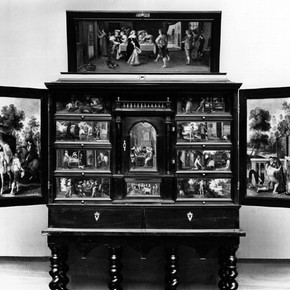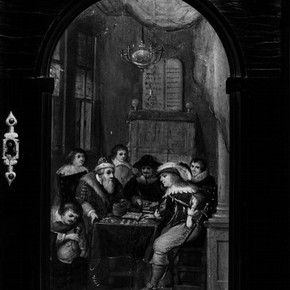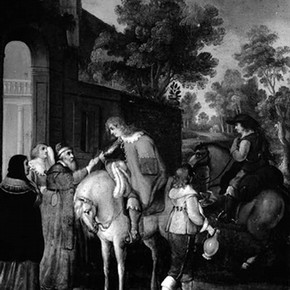Conservation Journal
April 1997 Issue 23
The Prodigal Son: Examination and conservation of a Flemish cabinet on stand

Figure 1. The complete cabinet, displayed with doors (W61-1923), 86cm high excluding the stand (click image for larger version)
Antwerp was an important centre for the arts throughout the seventeenth century, producing and dealing in paintings, prints, books, furniture and musical instruments. Highly ornate cabinets were made for storing valuable collections and became status symbols for the collectors. The wood most often used, at this time, was ebony, an exotic and expensive hardwood. Ebony was not used in the solid form for decorative profiled mouldings, but sawn into veneers to be glued on to a carcase of much cheaper native woods, such as oak and pine.
Such a cabinet was given to the Victoria and Albert Museum in 1923 (W61-1923), as part of a large collection of furniture donated by Mrs E. Hearn (Figure 1). Unfortunately, there are no records of who the designer, maker or commissioner was but it is believed to be from Antwerp from the second quarter of the seventeenth century. The stand is thought to be later, possibly a nineteenth century addition.
Looking through the conservation records we know that the cabinet was last treated in 1980. The technical record card states that only one small piece of missing ebony veneer was replaced and that several other areas were coloured out or reglued where loose. Lifting and splitting veneer is a common problem with this type of furniture.
In 1992 the cabinet was requested for loan. The object was examined in the gallery and a detailed condition report was made. It was found to be in a highly unstable condition and major conservation would be needed before it would be suitable to travel. Due to the low light levels in the gallery, it was difficult to determine the condition of the painted panels. These were thought to be in a stable and better condition than the exterior of the cabinet. However, some signs of flaking paint was noted on the small central door (Figure 2). In 1996 conservation, and in particular, consolidation of the painted panels, was requested by Furniture and Woodwork Collection, prior to open display in the Museum. The detailed condition report from 1992, mentioned above, proved to be very useful when drawing up a treatment proposal.
The cabinet was examined in the Furniture Conservation studio, where the space and higher light levels made examination easier than in the gallery. It was found that the overall condition of the cabinet was the same as in 1992 but that the painted panels showed flaking and tenting (a form of blistering resembling a tent) of the paint layers.
Treatment of the cabinet fell into two stages; dealing with problems associated with the woodwork and then the painted panels. Lifting veneers were stabilised and missing parts replaced before examination of the painted panels began. Nicola Costaras, Senior Paintings Conservator, generously shared her knowledge and time at this point. Examination by infra-red radiation showed that alterations had been made in some places and extensive retouching of the central door panel was apparent in ultra-violet (uv) illumination. A detailed technical analysis described later in this article was undertaken by Hannah Eastwood.
The panels required more attention; the flaking and vulnerable paint was consolidated with the adhesive, isinglass. This was brushed directly on to the painted surface, covered with acid-free tissue paper, gently rubbed with the ball of a finger and dried with a heated spatula set at 30°C. The painted panels were gently surface cleaned with saliva applied with cotton swabs. Previous retouching was softened with solvents and removed mechanically with a scalpel. The areas where both the ground and the paint were lost were filled with a paste of whiting (calcium carbonate) and gelatine. The fresh surface was shaped and cut back with fine scalpels and dental tools to resemble the texture of the original surrounding paint. The retouching was done with dry pigments in Rhodapas B™(Rhône-Poulenc), a polyvinyl acetate.
Analysis of the painted areas of the cabinet was undertaken to shed light on the materials and techniques that had been used for their construction. Small samples of paint were taken from areas adjacent to regions of loss avoiding obviously retouched areas. Polished cross sections were prepared and examined microscopically in incident light and under uv illumination.
A wide range of pigments were found to be present, all being consistent with seventeenth century usage and confirming that the painted areas formed part of the original cabinet. The wooden panels were prepared with two coats of a chalk white ground with the second layer containing coccoliths1, indicating the chalk was from a natural source. A thin brown underpaint had been applied over the white ground; consisiting of mainly brown ochres with additions of carbon black, yellow and red ochres, lead white, brown lake and vermilion - the exact mixture varying between samples. This technique was well known in seventeenth century Europe and often resulted in a dark, sombre effect 2.
The paint varies from being applied in a single layer to having three thin layers with glazes in some areas. An interesting point is illustrated by a sample taken from a brown area on one of the drawer fronts, where no further paint was applied. The brown underpaint was left as the top layer, demonstrating the artisits economy of technique (Table 1).
The green areas, such as foliage3 , have been painted using the synthetic copper pigments, green and blue verditer, mixed with a yellow pigment (lead-tin yellow or a yellow lake). This was common practice and the fading of the yellow lake pigment is responsible for the present distinct blue tone of the foliage (Table 2). Leadtin yellow is used dramatically for the gold highlights and gold braid seen clearly in crosssections from the chandelier and the blue jacket on the central panel (Table 3).
Three different blue pigments are present; azurite, blue verditer and smalt, a crushed cobalt blue glass. The bright blue areas, such as the blue jacket, consist of azurite applied over a gray underpaint (Table 3). Azurite, a naturally occuring blue copper carbonate, was fairly scarce and therefore expensive 3. The cheaper alternative of blue verditer was used in the larger and less intense blue areas like the sky. Tiny fragments of smalt are also present in the top layers of samples from the sky.
The pink robe of the old man on the proper right-hand door panel has an interesting layer structure (Figure 3). The two layers of white ground are followed by the brown underpaint and a pale pink paint layer (Table 4). A discoloured layer follows which is a mixture of smalt and a faded madder lake. This glaze was probably lilac originally but due to discolouration of both pigments the present day appearance is far from the original. The bright red areas contain mixtures of vermilion, red lake and red ochre with traces of lead white and carbon black. There is a single layer of varnish present on most of the cross-sections.
Conclusion
The cross-sections prepared from the samples taken from this cabinet have provided a detailed account of the materials used by the artist to create these enchanting images. The information was very useful for the conservator engaged in practical work on the cabinet by clearly showing the build up of paint layers and by directing the choice of pigments for retouching. The cabinet is now in a stable condition, displayed with the doors open in Gallery 3a. This project is a good example of collaborative work between two students of different disciplines, linking together the Furniture, Paintings and Science Sections of the Conservation Department.
List of Pigments found
Gold leaf, vermilion, silver leaf, red lake (madder), chalk, pink lake, lead white, lead-tin yellow, carbon black, yellow lake, azurite, yellow ochres, smalt, red ochres, blue verditer, orange ochres, green verditer, brown ochres and brown lake.
Further reading
M. Riccardi-Cubitt, The Art of the Cabinet, Thames and Hudson, London, 1992
References
1. Coccoliths are minute fossils which are present in chalk deposits. There is a good scanning electron micrograph of a coccolith in The National Gallery publication Art in the Making: Rembrandt, 1988, p27.
2. Darrah, J., Internal Science Group Report, Microscopy of Organic Materials - with details of analysis of 'The Musical Party' (Museum No. W.M.1524-1948).
3. Plesters, J., Art in Seventeenth Century Holland, National Gallery Catalogue, 1976, p6.
April 1997 Issue 23
- Editorial - The Raphael Cartoons at the Victoria and Albert Museum
- The Prodigal Son: Examination and conservation of a Flemish cabinet on stand
- Traditional practices for the control of insects in India
- Conservation of the 'May Primrose' wedding dress
- Exhibitions: How do they do it?
- The Arundel Society - techniques in the art of copying
- A visit to Liverpool
- RCA/V&A Conservation Course Abstracts
- Printer Friendly Version

